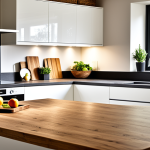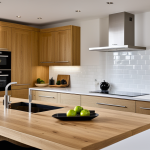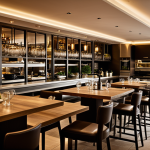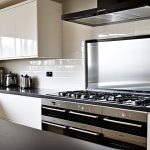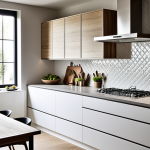Understanding Slim Kitchen Design
In the UK, where space constraints are a common issue, optimizing small spaces has become a necessity, especially in kitchen design. Typical UK kitchen dimensions vary, but many homeowners find themselves working with limited square footage. The challenge lies in making these slim kitchens not only functional but aesthetically pleasing as well.
An overview of typical kitchen dimensions in the UK reveals that many homes feature narrow galley layouts. These layouts demand a strategic approach to design, emphasising the importance of space optimization. To utilise every inch effectively, one must consider aspects like appliance placement, storage solutions, and workflow efficiency.
Also read : How Can UK Kitchens Be Designed for Enhanced Efficiency?
When it comes to slim kitchen design, several challenges must be addressed. These include finding the right balance between style and functionality, ensuring adequate storage without crowding the space, and maintaining ease of movement. With the right strategies, however, these challenges can be transformed into opportunities to create a kitchen that is both beautiful and functional.
Overall, the goal is to design a space that maximizes utility while reflecting the homeowner’s personal style, despite the constraints of typical UK kitchen dimensions.
In the same genre : How Can You Design a Sleek and Stylish Kitchen in Limited Space?
Space-Saving Solutions
Crafting a slim kitchen design requires leveraging every available inch, and this can be achieved through innovative space-saving furniture and storage solutions. Thoughtful incorporation of these elements can transform a cramped area into an efficient workspace.
Innovative Storage Ideas
Utilising vertical space is crucial in narrow kitchens. By installing tall cabinets and shelving, you can maximise storage without sacrificing floor area. Consider hanging pots and pans on racks to free up cupboard space while adding a rustic charm. Meanwhile, pull-out pantry shelves can keep essentials accessible yet neatly tucked away.
Multifunctional Elements
Incorporating multifunctional furniture ensures that every piece serves a dual purpose. For instance, an island with built-in storage and seating transforms a cooking space into a dining area. Similarly, appliances that combine features, like an oven with a microwave function, save room for other essentials.
Vertical Space Utilisation
Using vertical space for storage is about thinking beyond cabinets. Pegboards provide a customisable storage solution where you can hang utensils and tools, making everything visible and accessible. Investing in stackable kitchenware also contributes to a more organised and space-efficient kitchen environment.
By integrating these space-saving strategies, even the smallest kitchens in the UK can become thoroughly optimised for both function and aesthetic appeal.
Optimal Layout Suggestions
Designing narrow kitchen designs requires careful planning to ensure workflow efficiency and an aesthetically pleasing environment. When tackling a slim kitchen space, considering the best layouts, such as galley or L-shaped, can significantly influence functionality. These designs promote a streamlined workflow by organizing cooking zones along parallel or adjacent walls, maximizing the potential of restricted areas.
Best Layouts for Slim Kitchens
In a galley kitchen layout, placing functional areas on opposite walls allows for an efficient triangle of space—cooking, washing, and preparation—making it ideal for elongated spaces. This approach minimizes unnecessary steps, enhancing functionality in tight areas.
Alternatively, an L-shaped kitchen offers a unique advantage by using two perpendicular walls. This layout not only encourages smooth workflow but also introduces an open side. This openness aids in maintaining seamless integration with nearby rooms, often allowing for a small dining area.
Efficient Work Zones
Creating zones for specific tasks, such as a distinct area for chopping and one for appliance storage, helps reduce physical effort while cooking. Prioritizing accessibility ensures you have everything at your fingertips, reducing the clutter often associated with compact spaces.
Traffic Flow and Accessibility
Traffic flow is a crucial consideration, as it dictates how comfortably multiple individuals can move through the kitchen. Strategic placement of appliances and fixtures prevents congestion, allowing for smoother navigation even when the kitchen is in full use. Prioritizing accessibility ensures everyone can reach what they need without interruption.
Ideal Color Schemes for Slim Kitchens
Delving into color psychology can greatly influence how space is perceived in slim kitchens. Light colors, such as whites, creams, and pastels, are recommended for creating an illusion of more space. These colors reflect more light, making a kitchen appear larger and more open, which is especially crucial in narrow environments.
Recommended Color Palettes
To maximize the impact of light colors, consider combinations that blend seamlessly with the kitchen’s layout. For instance:
- Soft pastels paired with white cabinetry can add a sense of airiness.
- Neutral tones like beige or light grey create a contemporary feel while maintaining openness.
- Accent colors, such as light greens or blues, provide visual interest without overwhelming the space.
Lighting to Enhance Space
Lighting plays a vital role in enhancing kitchen aesthetics and the effectiveness of the color scheme. Under-cabinet lighting and strategically placed fixtures can emphasize colors, while natural light should be maximized whenever possible. This not only boosts the room’s aesthetic appeal but also enhances the perceived size of the kitchen.
By carefully selecting color palettes and lighting, small UK kitchens can become inviting and vibrant despite their limited dimensions.
Functional Design Considerations
When creating a functional design for a slim kitchen, usability must be at the forefront, ensuring that the space meets daily needs without sacrificing aesthetic appeal. Essential kitchen features should facilitate easy and efficient cooking while maintaining an inviting atmosphere.
Must-Have Features in a Slim Kitchen
A well-designed kitchen embodies both form and function by including features that streamline usage. High-quality, space-saving furniture such as pull-out tables or foldable counters provide flexibility and efficiency, enabling smooth transitions between meal prep and dining. Additionally, built-in appliances that blend seamlessly into cabinetry help maintain a clean and organised space, crucial for smaller kitchens where clutter can quickly overwhelm.
Balancing Aesthetics with Practical Functionality
Achieving a harmonious balance between aesthetics and practicality involves thoughtful choice of materials and finishes. While sleek, minimalist designs contribute to a modern feel, incorporating durable, easy-to-clean surfaces is imperative for long-lasting functionality. Choosing muted tones, subtly textured materials, and understated hardware can enhance visual appeal without compromising usability.
Importance of Quality Materials in Design
Incorporating high-quality materials is vital, as they contribute significantly to a kitchen’s durability and overall appeal. Hard-wearing surfaces like quartz or granite not only provide elegant countertops but also resist daily wear and tear. For cabinetry and flooring, options such as engineered wood or high-pressure laminates offer an aesthetically pleasing look with the robustness required for everyday use. Investing in exemplary craftsmanship ensures that a slim kitchen meets both current needs and stands the test of time.
Case Studies of Successful Slim Kitchen Designs
Exploring design examples reveals innovative strategies employed in UK homes to maximise utility in limited spaces. One standout case involves a Victorian terrace in London. The homeowners transformed their narrow kitchen by adopting an innovative galley layout, integrating multifunctional elements like a foldable breakfast bar. This real-life case highlights the significance of creative problem-solving in achieving both style and efficiency.
Another successful redesign project can be seen in a compact apartment in Manchester. This project utilised high ceilings to incorporate ample vertical storage, with hanging cabinets that maintained an open feel. The introduction of light pastels and light colors ensured the kitchen remained bright and spacious, employing both colour and layout to optimise the slim space.
Current UK kitchen trends emphasise the blend of functional design with aesthetic appeal. The use of space-saving furniture such as sliding doors and hidden storage solutions is prevalent. These cases illustrate the potential to transform limited areas into functional, stylish kitchens, offering inspiration to those tackling similar design challenges.


